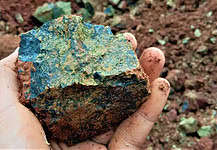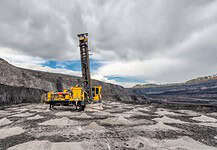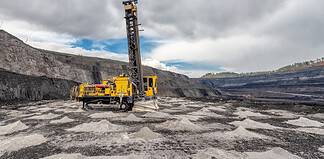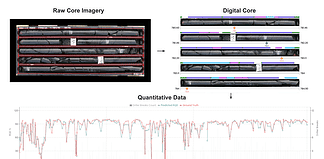BHP conducted the first blast at its South Flank project in September. Image: BHP.
BY AMY BLOM
MINING giant BHP is on time and on budget to deliver its multibillion dollar South Flank project, having taken off with a flying start in July.
South Flank has made a rapid start in its first three months of construction, according to project director Simon Thomas.
Speaking at a WA Mining Club lunch in Perth on 25 October, Mr Thomas said BHP already had more than 600 people working on the project, with local contractors such as NRW, Clough, CPB and Decmil mobilised to site.
He said September quarter highlights included an expansion of the Mulla Mulla village facilities comprising 756 operational rooms and central facilities, new mining facilities, expanded infrastructure at MAC process facilities, and the relocation of more than 20 million tonnes of waste from the footprint of the expanded rail loop.
The company has also awarded two large civil and earthworks contracts, and a stockyard machines contract.
BHP conducted the first blast at its South Flank project in September and was advancing construction with the aim of delivering first ore in 2021, followed by a three year ramp up.
The project, in WA’s Pilbara region, had an expected 25-year mine life and would replace the ageing 80 million tonne per annum (mtpa) Yandi mine.
South Flank In Detail
Mr Thomas said the $US3.6 billion project would be the single largest annual production iron ore mine BHP had ever developed, and the largest iron ore mining and processing facility built in more than 50 years of iron ore mining in the Pilbara.
“The South Flank deposit itself is huge, it’s 26km long, 2km wide and requires significant mining infrastructure and operations,” Mr Thomas said.
“For example, it includes two main mining areas, each supported by a 40mtpa primary crusher.”
There was also about 23km of overland conveyors, in addition to usual conveyors, coarse ore stockpile, product screening buildings, and a new train load-out facility and rail loop duplication.
The MAC stockyard was set to be expanded, and according to Mr Thomas, the new stockyard machines would be among the largest in the world.
Mr Thomas said the mine was spread over a large geographical distance with multiple work fronts, however the proximity of the South Flank deposit to the Mining Area C hub would enable BHP to further maximise the existing infrastructure and achieve economies of scale by processing ore through a larger central hub.
“It will create a mining infrastructure hub within reach of several billion tonnes of high-grade iron ore over its 25-year production life,” Mr Thomas said.
“This means what we’re building for South Flank will be integrated into the existing Mining Area C brownfields operating environment.
“This is where the integrated project team will execute both construction and operational readiness activities and our single team approach will ensure a safe, streamlined integration and handover with reduced risk to schedule.”
According to Mr Thomas the 80mtpa project would not just sustain the current level of iron ore production from BHP’s Pilbara mines, it would also allow the mining giant to increase the quality of its products by increasing the amount of lump.
Iron ore is crushed and split into lump and fines components, with lump product generally being richer in iron and lower in other minerals.
As an outcome of South Flank, BHP would increase the lump in its product suite from 25 per cent to 35 per cent.
“This will satisfy rising demand of high-grade fines and lump with the structural improvement of steel margins and more stringent environmental standards,” Mr Thomas said.
“The shift towards increased demand for higher quality materials driven by successful China steel side reform, positions the South Flank product to be in high demand by our customers.”
South Flank was expected to create 2500 jobs during construction and about 600 ongoing operational roles, with more than 9000 people expected to be involved over the life of the project.
The project would also have a strong focus on local contractors, with BHP expecting to award about 85 per cent of the South Flank spend to Australian companies, 90 per cent of which would likely be completed in WA.
BHP has already awarded 177 contracts worth more than $1.5 billion with $1.2 billion going to WA-based companies.
BHP reported that as at 30 September South Flank was 15 per cent complete, on schedule and on budget.
South Flank would eventually account for about 28 per cent of BHP’s future WA iron ore production and about 8 per cent of its overall EBITDA.
The deposit is about 130km north-west of Newman and about 8km south of BHP’s existing Mining Area C operation.
South Flank mining operation. Image: BHP.
Adapting To Change
Beyond the production and output, Mr Thomas hoped South Flank would set the standard for how BHP develops major projects in the future, as it continued to adapt to the changing mining landscape.
Changes included a simplified portfolio with a focus on owning and operating large, long-life, low cost, expandable upstream assets diversified by commodity, geography and market.
As part of the move to simplify its investments, BHP announced the $US10.8 billion sale of its shale assets in July.
Mr Thomas said South Flank was a sustaining opportunity for BHP that ticked all the boxes.
“With BHP operating different, and operating in different markets, the way we approach major project investment must also be different,” Mr Thomas said.
“We’ve changed our model at BHP for Western Australian iron ore major projects.
“What we’re doing with South Flank is all about bringing that operating model to life and setting us up for the future of projects.”
Mr Thomas said at the heart of the operating model was a collaborative environment with its contracting partners, free of the traditional layers of management that had previously existed on past projects.
The approach to recruitment and employment at South Flank would also stand as a point of difference, with a greater focus on a more representative and diverse workforce by offering greater flexibility and redesigning work to allow for more entry level pathways.
On 25 October, BHP announced it had already achieved a 35 per cent female workforce on the front line of the projects.
According to Mr Thomas there had also been a greater focus on technology and the move to automation.
“We see South Flank as an opportunity to build on our strategic investment in technology to drive further improvements across our mining value chain,” Mr Thomas said.
”And as we move to highly automated operations across the Pilbara, we have an opportunity to more fully integrate our supply chain from resource to market.
“We want to build on our success and drive automation further back, into our drill and blast, and load and haul operations, bringing the safety and productivity benefits we’ve seen across our fixed plant.
“We see South Flank as an opportunity to advance our efforts to become a fully integrated and highly automated business by 2025.”
The Bigger Picture
When completed, South Flank will join BHP’s Eastern Ridge, Whaleback, Mining Area C and Jimblebar, which form its Western Australian Iron Ore (WAIO) system, along with Yandi.
Yandi was expected to ramp down in the mid-2020s, in line with South Flank’s ramp up.
WAIO also consisted of four processing hubs, Newman, Yandi, Mining Area C and Jimblebar.
BHP reported strong numbers in its September quarter operational review, with total iron ore production increasing by 10 per cent to 61 million tonnes (mt) or 69mt on a 100 per cent basis.
Guidance for FY19 remained unchanged, standing between 241mt and 250mt, or between 273mt and 283mt on a 100 per cent basis.
At WAIO, increased volumes were supported by record production at Jimblebar and improved reliability across BHP’s rail network and port operations.
At its AGM in London on 17 October, BHP chairman Ken MacKenzie signalled the company would remain cautious in the face of market volatility and predicted price declines, though he confirmed the company had so far been unscathed by global uncertainties.
“We all know success is never assured; we work in an uncertain world and that’s why it’s important BHP is well-positioned to weather any challenge,” Mr MacKenzie said.
“We closely monitor the external environment, in particular, the market volatility triggered by current global trade tensions.
“While we haven’t seen a material impact on our business, we remain cautious in the near term.”
According to the Department of Industry, Innovation and Science, the iron ore price was forecast to decline to $US51 a tonne in 2020 as a result of an expected decline in steel production in China and a well-supplied seaborne iron ore market.
Meanwhile, Mr Thomas poured water on local fears of a looming skills shortage that could hurt new projects such as South Flank, saying BHP had already taken the potential challenge into account and that it had not surfaced as much as the company may have feared initially.









































